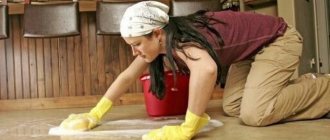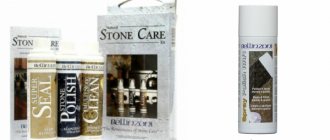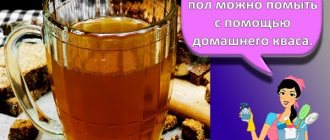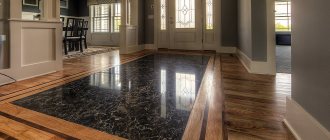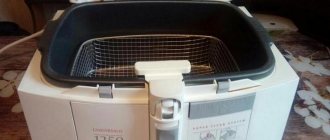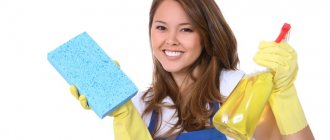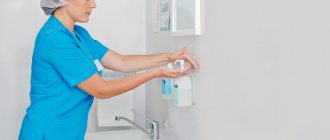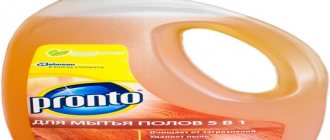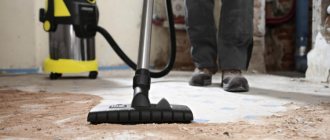Young housewives often face the problem of how to properly wash the floors. Periodic wet cleaning, in which surfaces are wiped with a cloth soaked in water, will not provide sparkling cleanliness. However, general floor cleaning must be carried out correctly, floor cleaning products must be appropriate for the type of flooring, and preparatory measures must be carried out with special care. Only if these conditions are met, the rooms will delight you with cleanliness, and much less time and effort will be spent on cleaning.
Basic rules for cleaning and cleaning the floor after whitewashing
Before you clean the floors, it is recommended to know about some nuances that will allow you to achieve maximum results. You should start washing the floor from the baseboards, moving from the walls to the center of the room, so that it is easier to collect all the dirt with a rag or mop. The unpainted surface must be moistened with a heated solution of water and soap, wiped with a brush, and then rinsed with water and wiped dry.
In the question of how to clean a painted floor, ammonia diluted in water will help. The surface is washed, dries for a while, and then it needs to be brought to a shine using cloth. If you have a problem with how to wash a “sweet” floor, you need to add a little acetic acid to the water and thoroughly wipe the sticky area.
The sequence of actions when cleaning the surface after whitewashing, which allows you to avoid severe stains, is as follows:
- Fill the entire contaminated part with a soap solution (highly concentrated);
- After all the remnants from the repair have acidified, collect all the dirt with a rag, rinsing it often in water;
- Add table salt or kerosene to a clean soap solution, moisten a rag in this solution and rinse the surface thoroughly;
- The final stage is the use of warm water and rags.
This way, the floor surface will be cleared of repair residues and there will be no white streaks left on the floor.
Eight
How to clean painted floors.
How to wash painted floors to make them shine using folk remedies As I mentioned earlier, proper floor washing involves drawing “figure eights”. The secret is that the mop collects small debris in circles, rather than spreading it across the floor in all directions. Then the mop is dipped into a bucket of water and after rinsing, all the fine dirt settles to the bottom. To draw “eights” on the floor, it is not necessary to have a higher art education, to be Nikas Safronov or a draftsman at Sukhoi JSCB. Although I read that in some very pretentious companies, they are now even looking for people with higher education for the position of cleaners and janitors.
Capitalism implies the opportunity to study at an institute or university for many years, to master the skills of space technology, for example, but in conditions of unemployment you will not be able to find something to do with your diploma. And then the doors open to low working niches. Cleaning the premises is one of them. So, regardless of your education and IQ level, it is better to wash the floor with a figure eight.
Advice to the housewife on how to quickly mop the floors without smearing dirt on the floor
How to properly and quickly remove old washable wallpaper
Many people wonder how to properly mop their floors so as not to spread dirt across the floor, but to actively get rid of it. This is not as simple a process as it might seem. Daily cleaning that drags on for a long time will not please anyone. Well-honed technology will allow you to get the job done quickly and efficiently.
General cleaning rules
There are a number of universal rules that must be followed during any cleaning. They are the basis for cleanliness in the room. With their help, you can even cope with the consequences of repairs yourself. Under no circumstances should such advice be ignored.
Before starting to clean the floor, it is better for the housewife to remove all foreign objects that complicate the process. For example, the carpet needs to be rolled up and placed in some other place. Chairs, stools, and shoes must be moved to the side.
It is recommended to start wet cleaning from the farthest corner of the room. You should start from the baseboard and wall, and then gradually move to the center of the room. This technique will allow you to avoid a large amount of garbage, which is difficult to collect, and to ensure high-quality cleaning of the room from dirt.
First of all, the surface is swept or vacuumed. At the same time, it is best not to ignore the far corners under the sofa and closet. Garbage that accumulates in the far corners of the room will move to the center of the room and significantly complicate the process of putting things in order. Therefore, we do not wash the surface, but clean it of accumulated dusty debris.
In order to avoid streaks, you need to wipe everything very carefully. Sometimes even several times. Detergent may leave residue behind. If the housewife wants to avoid unnecessary difficulties and significantly speed up the process of putting things in order, then she should use only high-quality products. They are designed specifically for cleaning this surface. You should not use powder, as it will be quite difficult to wash off.
Cleaning after major repair work
If you need to clean the floor yourself from the consequences of repair work, the procedure will take a little longer. Major cleaning consists of 3 main stages. First you need to wash the surface with ordinary warm water. This will help remove the root cause of the stain and expose the stains that will be the most difficult to remove.
After washing the entire surface with warm water, you need to begin removing traces of paint, glue, putty, whitewash and other building materials. If necessary, use specialized tools. Some marks are not so easy to wipe off.
Next, the floors are wiped with a damp cloth to remove other dirt. This technique will help you cope with global pollution yourself and save on the services of companies that specialize in cleaning various surfaces.
Stains left by varnish and paint can be removed in various ways. It is worth noting that for each coating you should choose the most gentle product.
Modern detergents will help you avoid using materials such as kerosene and vinegar with water. The enamel can be cleaned with a knife. Paint and varnish can be easily wiped off with acetone.
It is very difficult to remove whitewash from the surface. The stains that remain after it will need to be washed several times. By changing the water 2-3 times during the cleaning process, you can easily cope with this task. Adding special tools to it will help speed up the process significantly.
Unlike public spaces, in your own apartment you don’t have to use a mop, but rather use your hands. The main part of the room is cleaned using a tool, and hard-to-reach corners will be easiest to wash by hand.
Influence of surface coating on the choice of cleaning method
Cleaning a room with different types of coating has its own characteristics. The floor can be painted, covered with linoleum, laminate or parquet. Concrete, tiles and even ceramics are used as the surface.
It must be remembered that parquet and laminate do not require special wet cleaning. It is best not to wet such a coating, but to clean it with a damp brush or dampened rag. Linoleum, concrete, tiles and ceramics are washed with ordinary warm water. To remove complex contaminants, specialized products are used. The painted floor is cleaned with a wet stiff brush. Caring for a cork surface is similar to caring for parquet.
Types of mops
- Rope. They are mainly used for wet cleaning of fairly dirty rooms. Thanks to their high hygroscopicity, cleaning is quite simple. They cope well with dust and dirt without leaving streaks.
- Looped. Thanks to these very loops, the mop can capture more dust from the surface, which saves you time. Can be used for both dry and wet cleaning.
- Cotton. This type is well suited for wet cleaning of the house. This type of attachment will serve you for a long time and is not very expensive.
- Acrylic. Designed for dry cleaning. Can be used on floors, ceilings and walls.
- Made from microfiber. They absorb water perfectly, so they can be used when cleaning large areas. It is also recommended to use them for cleaning parquet and laminate floors.
Mops are attached in these ways
- Fastening "under the ears". This mount is different in that it has a specially designed pedal for squeezing the mop. To squeeze water out of it, just press this pedal. This option is perfect for people who have difficulty bending over.
This mop has many benefits. One of the main advantages is its versatility.
It can be used for dry and wet cleaning of absolutely any surface without leaving any traces of dirt or streaks. The main thing is to choose the right nozzle. The presence of a rotating mechanism allows the mop to reach the most inaccessible places in your home, for example, under furniture. You can buy a flounder mop in hardware stores or online stores, which is very convenient. The price of flounder is from 600 rubles and above.
Washing various floors
How to properly use, wash and store a spray foam gun
Of course, the simplest and still relevant way is to pour plain water into a bucket and arm yourself with a mop. But to achieve excellent results, in order to wash your floors so that they shine, you will have to use some tricks.
Pay attention to the floor covering, we will apply a different technique to each covering
Linoleum
Linoleum is easy to clean with plain warm water; wiping it thoroughly will result in shine. Don’t even think about adding soda to the water; this method has long been outdated, and you will only ruin the surface of the linoleum.
If you still want to add detergent to the water, then use regular or laundry soap. Soap will not harm your linoleum, and you can always wash off the resulting foam with water.
Using a modern mop makes work easier
To maintain the good condition of linoleum, many people use special polishing agents, an analogue of which is natural drying oil. Rubbing linoleum with drying oil once a quarter will keep it in shape.
Parquet
It is not recommended to wash parquet; it will be enough to vacuum or sweep it. If this is absolutely necessary, it is recommended to use a damp cloth, which will quickly refresh the floor covering.
It is recommended to use glycerin as a detergent for parquet; it is suitable for both patched and untreated parquet.
Parquet cleaning work
Approximate proportion: spoon per glass of water.
Ceramic tile
Ceramic tiles, like linoleum, can be easily and quickly washed with warm water and a soft cloth. However, as with hardwood floors, you will need to vacuum or sweep first. Some dirt can be removed from the tiles using a brush with plastic bristles. You cannot use brushes with very hard bristles or iron ones at all, as they will damage the tiles and seams.
If you plan to use extra strong chemicals to wash the tiles, make sure that they do not contain aggressive acids. Cleaning ceramic tiles on the floor
Cleaning ceramic tiles on the floor
Preparation
In every case, preliminary preparation is important. It is necessary to draw up a further plan of military action, figuratively speaking. There is a springboard - a living room, for example. You need to make a forced march to the bridgehead with a rag and a bucket, and to do this you must “clean” it according to all the rules of military affairs. “Cleansing” involves eliminating the enemy—dust and dirt—through extermination or deportation. In our case, we first need to lift all the stools, hangers, chairs and other objects that are possible upstairs and remove them from the floor.
At home, after removing everything unnecessary, take a broom and dip it in a bucket of water. Just the tip. There is no need to shove it all the way into the bucket and create a Gulf Stream there. Wet the broom. To drive off excess water, just tap them on something. According to mother-in-law it is prohibited! But about the edge of the bucket - please. Next, we use a wet broom to go through the entire area of work, removing large dirt and dust. This is done with a wet broom so that dust does not swirl around the room or settle in the respiratory tract.
Folk remedies for cleaning floors
Today there are many different types of floor cleaning products on the market. But if you are allergic to household chemicals or you are simply against such products, there are many folk recipes that are no less effective and safer.
The simplest recipe is to add a cup of soap shavings (or liquid soap) and table vinegar to a bucket of water. This product cleans and disinfects floors well.
Oil stains are first sprinkled with adsorbents (salt, soda or starch), and then cleaned with water and dishwashing detergent.
Boil several spruce branches in 2 liters of water. Strain the broth, add 3-4 tbsp. l. salt, soda and soap shavings. Stir and simmer over low heat for about 15 minutes. Add the cooled mixture to the water for washing floors at the rate of 6-7 tbsp. l. for 10 liters of water.
To clean the floor from dirt and grease stains, prepare the following product: mix 1 cup of water, 0.5 cups of vinegar and 0.5 cups of vodka (or diluted alcohol). For flavor, add 0.5 tsp. essential oil, such as orange. This mixture removes dirt, bacteria and mold.
Nail polish remover will help remove brilliant green from the floor (if the floors are not varnished).
How to properly wash floors after renovation
The hardest thing to clean is the floor after renovation: traces of whitewash, stains, stubborn stains and various debris remain on it. It is recommended to clean floors in 3 stages:
- First of all, wash the floor with clean warm water to remove dirt and identify all stains that need to be wiped off;
- remove stains after painting, wash off traces of whitewash, putty and glue;
- Wipe the floors with a damp cloth to remove any remaining dirt.
There are different ways to clean the floor from stains after renovation. For each coating you need to choose the appropriate methods and means
Previously, when washing floors after renovation, housewives added kerosene to the water, and completed the cleaning with water with the addition of vinegar. Today you can use acetone, white spirit and other solvents - they wash latex and nitro paints well. Water-based paint and whitewash can be cleaned with water or a soap solution: just wash the floors several times, thoroughly rubbing the contaminated areas.
Regular table salt will help get rid of traces of whitewash. Wash the floors with clean water to remove major dirt, and then add salt to the bucket (1 tablespoon per 1 liter of water). Finally, wipe down the floors with a mild vinegar solution.
You can wash whitewash with potassium permanganate. Simply dissolve a few crystals in a bucket of water and wipe the floors.
The hardened lime must be carefully removed with a spatula, and then rinsed with hot water with the addition of 100 ml of vegetable oil (per bucket of water). After cleaning, wipe the floor with water and vinegar.
Cleaning with a mop
You can clean the floors with a mop. The use of such a cleaning item has its own characteristics. First of all, it should be comfortable, so its height is selected correctly. The handle of the mop should reach the armpits, which allows the woman to strain her back less while cleaning. In addition, thanks to this height, the tool can be washed even in the most difficult to reach places in the house.
The quality of cleaning largely depends on how the mop is used. So, while cleaning, you need to draw a “figure eight” on the floor surface. This allows you to quickly collect all the garbage in the center without taking it all over the apartment. Do not wet the mop too much, as excessive moisture will greatly damage any surface.
Once you understand how to use a mop correctly, you need to learn how to clean various floor coverings.
Wooden floors
You can easily and quickly wash a wooden surface. If the boards are not painted, use cool water and detergent. You should not wring out the rag, but rather walk across the floor and wet it thoroughly. Then take a mop with stiff bristles and clean the surface with it. Walk on the foam floor with a damp cloth soaked in clean water. After this, you can wipe it with a dry cloth.
Varnished or painted wooden surfaces can also be washed with a soft cloth and detergents. In this case, do not use a brush to clean the coating. It is recommended to wash floors with a damp cloth and wring it out well. You need to move from the outer wall of the room to the exit along the baseboards, washing the center of the room at the end.
To add shine to the surface, mix methyl alcohol and vegetable oil in equal proportions, apply the composition to a rag and wipe the dry surface. When painted wood floors are dry, they must be wiped with a solution of table vinegar diluted in plenty of water. Thanks to this, the paint gains strength and additional shine. You should not carry out general cleaning of wooden flooring too often.
Parquet cleaning
Parquet flooring is also considered wood, but it is made from small planks. A varnish must be applied to such a coating. Thanks to this, excess moisture does not penetrate into the wood structure and the surface can serve for many years. It is not recommended to wash parquet too often, and for cleaning you need to use a well-wrung out damp cloth. To add shine to the coating, it is recommended to add glycerin to the water. As soon as the surface is dry, it must be rubbed with a special mastic and polished to a shine with a specially designed brush or suede cloth. You can wash parquet once a week.
How to clean laminate flooring
After washing the laminate surface, streaks and stains may remain on it. To prevent this from happening, there are several effective ways. You need to add a tablespoon of shampoo, dishwashing detergent or liquid soap to the water for wet cleaning, but it is best if it is gel washing powder. When washing, you need to change the water more often and rinse the surface thoroughly after using detergents.
For the next method you will need hot water, 9% vinegar and a mop with a soft attachment. Vinegar is poured into the water, thanks to which the moisture quickly evaporates from the floor surface and prevents streaks from occurring. Having dampened the rag, they begin to wash the floors, moving back towards the door.
To eliminate more serious contaminants in the water, you need to dissolve more detergent and foam it. The foam is applied to the surface and washed off after 10 minutes with a clean cloth. You can wash laminate flooring no more than three times a week, and carry out general cleaning once a month.
Linoleum and porcelain tiles
The basic rule when washing linoleum floors is that you should not use hot water or abrasive cleaners. Linoleum should be washed when it gets dirty. Once a month it is recommended to wipe it with vegetable oil or drying oil. This allows the coating to return to its plasticity and prevents premature brittleness.
If the porcelain stoneware floor is very dirty, acid-based products added to water are used to clean it. Soak a soft cloth in the liquid, wring it out and wash the floor. After this, go over again with a cloth soaked in clean water and wipe with a dry cloth.
Master Class. Cleaning tile joints.
What is important here is not only the finish of the wooden floor, as mentioned earlier, but also how deep the stain is. Below you will find several useful methods that will help you, regardless of the depth of the stain.
Step 1: Mix 1⁄2 teaspoon dish soap with a little warm water to make a cleaning solution.
Dishwashing liquid mixed with water
Step 2: Mix the ingredients until a lot of soap suds appear.
Stir the solution until a lot of soap suds appear
Step 3. Dip a soft cloth into the resulting solution (more precisely, into the foam).
A rag is dipped into soap suds
Step 4: Wipe off the ink stain on the floor with a rag.
Using a soapy rag, gently wipe away the ink stain.
Step 5. After this, take a damp, clean cloth and remove the foam from the floor.
Use a clean, damp cloth to wipe off any foam from the floor.
Step 6: Dry the floor with a dry towel.
The floor is wiped with a dry towel
Step 7: See if the stain remains. If there are any left, proceed to the next step.
Check if the stain remains
Step 8: Prepare a piece of very fine steel wool (No0000) and dip it in the liquid wax.
A piece of fine steel wool
Step 9. Run cotton wool over the area of contamination - it will remove only the top layer of coating.
Lightly rub steel wool over the stained area.
Step 10: If necessary, you can polish or wax the floor.
Finishing the floor after stain removal
Method No2. Soda
Step 1. Surface stains can also be removed using baking soda. Mix it with water to get a paste-like substance.
Soda mixed with water
Step 2. Apply the resulting paste to the stain and rub it in. Be careful not to rub too hard or you may damage the finish.
The paste is rubbed into the ink stain
Step 3: Wipe the stain with a soft cloth dampened with clean water to remove the paste.
The paste is wiped off with a wet cloth.
Step 4. Repeat similar steps until the stain completely disappears. For larger spots, this will have to be repeated at least several times.
Repeat the entire process again until the stain is completely wiped off.
Step 5: Finally, wipe the wood floor dry.
Wipe the floor dry
Step 6. If necessary, you can wax the floor.
If necessary, wax the floor with a layer of wax.
Step 1. Soak a rag in white spirit and lightly wipe the stained area with it.
The rag is moistened with white spirit
Step 2: Dry the floor with a clean, damp cloth. If traces of the stain remain, then repeat the procedure, but this time use the same thin steel wool.
Using fine steel wool
Step 3. Rub cotton wool soaked in white spirit onto the desired area of the floor. Move along the grain, working carefully to remove as little coating as possible.
Try to remove as little trim as possible
Step 4: Wipe the floor with a clean cloth.
Take a clean rag and wipe the floor with it
Step 5. At the end, all that remains is to polish the required area of the wooden floor.
Polish the damaged area of the floor
Step 1: Apply a small amount of denatured alcohol to the desired area of the floor.
The stain is sprayed with denatured alcohol
Step 2: Wipe the floor with a clean, soft cloth to remove dirt and dust.
The floor is wiped with a rag
Step 3: Sand the surface to remove the finish.
Sand the surface
Step 4. Remove any debris from the surface.
Garbage is removed
Step 5: Dampen a soft, clean rag with mineral spirits.
Take a clean, soft rag and dip it in white spirit
Step 6: Dry the desired area with this rag.
Use this rag to wipe the surface of the wood.
Step 1: Apply undissolved bleach to the stain using a clean, soft rag.
Use a soft, clean cloth to apply undissolved bleach to the stain.
Step 2. Wait 10 minutes for the wood to become saturated with bleach.
Wait 10 minutes
Step 3: Look at the stain. If it is still noticeable, repeat the procedure.
Inspect the spot
Step 4: Then rinse the floor thoroughly with clean water.
Rinse the floor surface thoroughly with clean water
Step 5. Dry the surface with a clean, dry towel.
Wipe the floor dry
Step 6. After 24 hours, polish the wood floor.
After 24 hours, polish the floor
Step 1. Oxalic acid is most effective when removing blue paint stains. It is advisable to use warm acid.
Oxalic acid
Step 2. Take about 100-120 g of oxalic acid crystals, dissolve in 1 liter of hot water.
Acid dissolved in hot water
Step 3. Apply the resulting solution to the stained area using a clean, soft cloth.
Using a soft, clean cloth, apply acid liberally to the stained area.
Step 4. Wait until the floor is saturated with acid. This may take anywhere from 10 to 60 minutes, depending on how severe the stain is.
The floor surface should be saturated with acid for 10-60 minutes
Step 5: Scrub the stain thoroughly using a stiff brush.
Take a stiff brush and scrub the stain with it.
Step 6. Rinse the floor thoroughly using clean water.
Rinse the floor surface thoroughly
Step 7. After this, wipe the surface dry.
Wipe the floor dry
https://www.youtube.com/watch?v=sLMjZAvPiJY
Step 8. After a day, re-polish the floor.
Step 1. In this case we are talking about a very strong bleach, and therefore it should be used only in extreme cases, i.e. for very serious ink stains. The product is sold as a set, which also contains sodium hydroxide.
Hydrogen peroxide
Step 2: Take a sponge and place it in clean water.
Soak the sponge in clean water
Step 3: Place a sponge on the stain to dampen the floor surface.
Apply a wet sponge to the wood
Step 4: Apply hydrogen peroxide and sodium hydroxide, pre-mixed according to the manufacturer's instructions, to the stain. Try to apply the mixture evenly over the entire area of the stain.
Apply the mixture evenly over the entire surface of the stain
Step 5. Next, wait the required time (also indicated by the manufacturer).
Wait a while
Step 6: Polish the desired area of the wood floor.
Eraser
Wash the floor
How to clean different floor coverings
Laminate flooring should first be treated with a special paste and then polished. And in no case should such a floor be wet or damp, because having absorbed moisture, it can deteriorate - swell or change color, becoming duller.
Knowing how to clean parquet floors is equally important. To paraphrase a famous quote: To wash or not to wash, that is the question? And the answer to this question is obvious. Of course, you can wash a parquet floor, but you shouldn’t do it often; it’s better to use a vacuum cleaner
The varnish layer of parquet is very easy to spoil, for example, with sand, which, like sandpaper, will leave scratches, destroying the surface. It is better to remove more serious stains using a slightly damp cloth with a special product applied to it, designed for cleaning parquet flooring.
In an apartment where the floor is covered with linoleum or other polymer coatings, first of all, you need to ensure that a special product is applied to it, which will ensure the appearance of a protective film that prevents the occurrence of abrasions and dirt of various types. Such products are made on the basis of a soap solution, and will cost you much less than replacing the coating with a new one. They should be used approximately 1-2 times a week, depending on how dirty the floor is. And during general cleaning, which is preferably carried out 1-2 times a year, it is recommended to use a special cleaner.
When we wash epoxy-coated floors, we should take into account that they are susceptible to discoloration when exposed to alkali. Therefore, it is worth taking a responsible approach to choosing a detergent and, at least once a month, applying a special protective layer to the coating.
How to wash floors in a carpeted apartment?
Perhaps this issue should be approached most seriously, because it is important to keep such decoration of your apartment not only clean, but also to provide it with an attractive appearance, as it was originally. Most modern vacuum cleaners come standard with several special attachments and brushes for cleaning carpets.
Cleaning with their help will help remove even dirt invisible to the naked eye. Wet cleaning can be done using special carpet cleaners, which are freely sold today in any supermarket, as well as dry powder, which can easily remove stains from carpet made from natural materials.
In modern stores, the range of cleaning products and detergents not only for floor coverings, but also for your windows is expanding every day. After all, the entry of dust into the room depends on how you wash the window. In addition, with modern window cleaning products you can quickly achieve ideal cleanliness without streaks. Your windows, shining with cleanliness, will delight the eye with an image of the world undistorted by stains.
Also, keep in mind that each manufacturer of floor coverings indicates on the packaging with what products it is advisable to use to clean a particular surface. By approaching this issue seriously, you will preserve the hygienic cleanliness and beautiful appearance of your floor for a long time!
Varieties of flounders
These mops differ from each other in size, mop attachments and the material from which they are made.
A flounder is a mop that has a flat, rectangular platform.
A flounder mop can have a size from 30 centimeters to 80. If you need to clean the floors in a small apartment, the smallest flounder will be enough. When cleaning a larger area, you can purchase a flounder of a more impressive size. This will make the floor cleaning process easier and faster.
How to use a mop
A common mistake is using a mop designed to absorb liquid to clean the floor. Such a mop will quickly collect and retain all the moisture, but the floor cannot be called washed.
Wiped - yes, but for washing it is better to choose a more suitable tool. A microfiber mop is most suitable. Its fibers collect dust, dirt, and small debris, and you don’t have to sweep the floor first, raising dust and spending extra time on cleaning.
Proper care of mop heads is an issue that does not seem to be directly related to floor cleaning. But a clean nozzle is the key to subsequent high-quality washing, the absence of bacteria and harmful microorganisms.
Some rules for caring for microfiber nozzles will extend their service life and ensure effective cleaning:
- You need to wash the nozzle by hand or in a washing machine, using laundry soap or mild detergent;
- Do not boil;
- Do not use chlorine bleach when soaking or washing.
Choose quality cleaning products that match the type of flooring. Use proven household, or better yet professional, products, choose the right mops and other equipment, and your floors will respond to proper care with perfect cleanliness, shine and preservation for many years.
Maria IvanovaHousewife
Mother of two children. I have been housekeeping for more than 7 years - this is my main job. I like to experiment, I constantly try different means, methods, techniques that can make our life easier, more modern, more fulfilling. I love my family.
Sections of the site
- News
- Family and children Children's health
- Development and education of children
- Goods for children
- For women
- We live in cleanliness and order
Handicrafts
- Signs and superstitions
Travel
Results
Features of use
For those who do not understand what a mop mop is and doubt the need to purchase one, it is worth citing a number of advantages of such cleaning devices:
- the ability to use attachments for both dry and wet cleaning;
- low price (from 100 rubles *);
- the ability to wash the floor and windows quickly and without streaks;
- MOP can easily be washed in a washing machine and dries quickly;
- Such nozzles do not accumulate chemicals that have a negative impact on human health.
Linoleum
Linoleum is a durable floor covering if properly cared for.
Cleaning should be carried out quickly and carefully, avoiding the appearance of scratches and dents on the soft linoleum, which are impossible to get rid of. Cleaning chemicals are of an alkaline reaction type. Equipment – a mop with a microfiber attachment or a rag made of bamboo fiber. Do not use acetone-containing or abrasive products or use them carefully with a mandatory preliminary test on an inconspicuous part of the coating. May cause abrasion or fading of the design. Do not wash with hot water, do not rub with soda, do not clean with gasoline, ammonia... A little trick! Restoring the shine of linoleum is possible by wiping it with a woolen rag soaked in water and milk mixed in a 1:1 ratio.
Little trick! Restoring the shine of linoleum is possible by wiping it with a woolen rag soaked in water and milk mixed in a 1:1 ratio.
What to look for when purchasing
To prevent cleaning from causing much inconvenience, when choosing a mop you need to pay attention to the following aspects:
- Handle quality. It is better if it is made of plastic with iron or polyurethane. An all-plastic handle may break quickly, while an all-iron handle will not be mobile enough.
- Quality of the cloth/nozzle. If the choice falls on high-quality devices, then you should not take rope and sponge models, as well as the “butterfly”. Their attachments wear out quickly and require replacement. It is better to consider electric mops, T-shaped, flounder and steam options.
- Build quality. The device must be movable, flexible, and preferably rotate. A stationary mop that only moves in one direction is not the best choice for general cleaning.
Basic recommendations
There are rules that are known to experienced people. The floors in the house need to be washed efficiently and quickly. These tips will also help you clean the room after renovation.
Even before the cleaning process begins, you should move all the objects that are on the floor. Roll up the carpet so it won’t create any interference, and place the stools to the side. First clean the floor with a vacuum cleaner or simply sweep the room
It is important to inspect the space under the bed, sofa, and look under the closet. The dust that accumulates there may force you to start cleaning all over again if you don't clean these areas first. Cleaning should begin at the furthest point from the door.
First you need to wash the area around the baseboards and walls, then move on to the central part of the room, and then to the exit. To get rid of stains, you should thoroughly wipe the floor with a slightly damp cloth or dry it with a mop; the floor should be washed several times.
Conclusion
Remember: the dirtiest place in any room is the flooring. Sometimes you can wash the floors every day, or even several times a day. No matter how clean you wash the surface, after a day or two dust, pet hair and other debris will still begin to accumulate in the corners. Whatever way you decide to clean your floors, you need to do it with joy, perhaps even love, and then the floor will not just be clean, but sparkling. Your family will appreciate it, and you will be pleased to enjoy the results of your work.
READ MORE: How to properly remove dust from a concrete floor in a garage with your own hands
Floor type
An important criterion when choosing a detergent and method of cleaning floors is the type of coating. Linoleum, tile floors, parquet, cork, wood and marble are cleaned in different ways. Let's find out how to properly clean floors depending on the type of floor covering.
Parquet
Parquet does not like moisture, so it should not be wetted too much. To remove dust, just vacuum or sweep the parquet with a soft brush, and then wipe with a damp, well-wrung out mop. This procedure can be carried out several times a week.
Parquet is the most environmentally friendly and durable type of flooring. It doesn't like moisture, so it shouldn't be wetted too much.
It is recommended to resort to more thorough cleaning no more than 1-2 times a year, so as not to damage the coating. For such cleaning, use cool water and special moisture-proofing and polishing products.
Parquet parquet that has dried out from water (there was a large pot with a flower in this place; the owners did not immediately notice that the floor was suffering from excessive watering)
Laminate
Laminate, like parquet, does not like water. And although today there are moisture-resistant types of laminate, they also cannot be filled with copious amounts of water. To properly wash laminate floors, use a well-wrung out cloth. During general cleaning, you can use a special product for this coating or liquid soap.
Remember: excess water is absorbed into the floor covering and leads to swelling and deformation of the laminate boards. Wipe laminate floors only with a damp cloth
The following video will tell you how to properly wash laminate flooring:
Linoleum
Linoleum is one of the most picky types of coating. It can be washed with warm water and regular detergents. It is recommended to clean linoleum once a week with a solution of laundry soap. The most important thing is not to use ammonia.
A warm solution of soap and soda washes dirt off linoleum well.
If you want to make the floor shine and remove stains, wipe it with a soft cloth soaked in milk. Once every 3-4 months, you can treat the linoleum with drying oil and polish it with a cloth - thanks to this care, the floor will always look like new.
Tiles and marble
Tiles (tile flooring) are an unpretentious type of flooring. She is not afraid of water and detergents. The tiles can be wiped with soapy water or alcohol, vinegar and chlorine-containing agents can be added to the water.
To make the tiles shiny, add lemon juice to the water for washing floors (for 3 liters of water, 1-2 tablespoons of juice)
It is best to wash marble floors with an alkaline solution - it easily removes dirt and does not damage the surface. Another effective cleaning solution is a mixture of water, hydrogen peroxide and a few drops of ammonia.
To clean very dirty marble floors, use a stiff brush and an alkaline solution.
Painted floor
Painted floors are easy to maintain, but require regular cleaning. It is recommended to wipe it daily, especially in rooms where dirt quickly accumulates (hallway, kitchen). Wash floors correctly with a cloth soaked in a weak solution of ammonia or vinegar - this will add shine to the paint. Just dissolve 1 tbsp. l. of the selected product in 1 liter of warm water.
To make the floor shiny, after drying, lubricate it with a thin layer of linseed oil.
If the paint has worn off in some places, use a parquet mastic that matches the color.
Grease stains on a painted floor should be moistened with soapy water and left overnight - in the morning the dirt will be easily washed off with warm water.
We invite you to watch a video where one of the units can easily cope with washing a wooden terrace:
Unpainted floor
To clean unpainted floors, use hot water and a stiff brush. Wooden boards can be polished and bleached.
It is preferable to wash this type of floors correctly with soap and alkali: moisten the floor with the solution and scrub with a stiff brush. You can add a little turpentine to the water.
If you take care of an unpainted wooden floor (walk on it in slippers, not dirty boots), then one wet cleaning per week will be enough
Cork floor
This type of floor should be properly washed with a soft, damp cloth, without using chemicals or abrasive detergents.
Cork, like parquet, should not be wetted excessively.
Do not use wire brushes; It is better to remove dirt with a sponge or sandpaper.
If the cork floor is covered with a vinyl surface, it must be periodically lubricated with a special mastic, after first cleaning the old layer with a solvent.
Description of MOP nozzles
It happens that the MOP mop attachment is perceived as a whole cleaning device. But in cleaning companies, a device for cleaning surfaces is called a flounder. This term refers to a device for washing floors, walls and windows, the peculiarity of which is a flat holder on which a replaceable nozzle is placed. It is impossible to say about MOP that it is a complete cleaning equipment. Despite the fact that in English the word “mop” means a mop as a whole, this concept came into Russian as its replaceable part.
Types of MOP nozzles
Flat mops are inexpensive, their handles can be plastic or metal, and most often they are adjustable in length. Depending on the type of flounder, there are several types of MOPs:
- combined nozzles consist of soft long cotton flagella that absorb water and are easily wrung out. They are collected in one bundle, ending with a plastic threaded mount that is screwed to the corresponding thread on the mop. Advantages of rope MOPs: ease of use, the ability to penetrate hard-to-reach places in the room, the ability to wash cracks and seams;
- Tufting is a flat cotton nozzle that is suitable for regular cleaning of medium-dirty areas. Attaching to the base occurs with the help of “ears” and loops at once, thanks to which it stays on it tightly. The main advantages of this type of MOPs are the ability to absorb water well and high wear resistance. This allows cleaning not only in apartments, but also in high-traffic areas;
- loop (loop) MOP is 100% made of microfiber, which makes it rot-resistant and resistant to acids and alkalis. This allows you to disinfect the floor with such a mop. Another advantage is the high level of water absorption.
Interesting! Loop MOS most often comes in gray color, unlike its other bright counterparts.
Approximate figures
Estimated energy costs for household chores, averaged data from many sources:
- 60-80 kcal per hour is killed only by being in harsh kitchen conditions with temperature changes and high humidity;
- 200 kcal per hour of preparing food for cooking: cutting meat, washing fruit, peeling and cutting vegetables;
- 200 kcal per hour is consumed when washing dishes, despite the apparent ease of this activity, the back muscles take on more energy consumption;
- 200 kcal can be lost in an hour of cleaning the closet, while ironing only takes 150 kcal/hour;
- 150 kcal per hour is spent on the process of making the bed, which must be done every day in the morning, but if you have not done this, do it now;
- 300 kcal are consumed in one hour when wiping off dust with a damp cloth; if you climb into hard-to-reach places, calorie consumption increases, but does not rise above 350;
- 250 kcal are spent for 1 hour of working with a vacuum cleaner, after all, the device tries harder than you, so move more actively around the apartment;
- 300 kcal - this is exactly how many calories are burned per hour when washing windows, and since this process is very labor-intensive and slow, it is an excellent half-day activity;
- 350 kcal per hour is burned when washing the floors with a mop, but if you wash the floor with a rag while kneeling, then the calorie consumption is close to 400;
- the same number of calories per hour (400) are spent when washing tiles in the bathroom, treating them with compounds against mold and mildew;
- 350 kcal per hour will be spent by you when washing the sink, toilet, bathtub, shower stall; to a greater extent, calories are consumed due to difficult working conditions;
- 300-350 kcal per hour will be burned during hand washing, the number of calories will depend on the volume of items.
Note that complex cleaning requires spending even more calories, so try to combine complex tasks with easy ones, for example, after simple manipulations with dust, start washing the floors, and then again choose a less labor-intensive task - disassemble the shelves in the bathroom.
Thorough cleaning of the floor
It is very important to burn more calories by not taking frequent breaks while cleaning. Maximum calorie consumption is achieved after 15-20 minutes of vigorous activity, i.e.
from this time forward, every action will destroy as much energy as possible.
If you take a long break, the muscles will cool down and it will take another 15-20 minutes to reach the optimal mode. By this time you will already feel some loss of strength, so you won’t be able to hold on at this pace for long.
If we take average data, then in an hour of cleaning you will in any case spend about 300 kcal. It’s easy to calculate that for half a day of active weekly cleaning you will spend about 1200 kcal. An impressive amount, but to achieve it you will have to work hard.
The cleaning is done, it's time to rest
Energetic music, which you can choose at your discretion, will give you excellent tone. To the rhythms of your favorite songs, things will go more actively, and time will fly faster. You won’t even notice how you’ll lose a lot of calories.
But even after putting things in order in the apartment, putting yourself in order, you will spend additional calories. After which, looking at the cleanliness of the house, you will be satisfied with yourself and your work. Just don’t try to overeat at night, after such a good, physically difficult day of work. How much effort has been spent, is it really all in vain?
https://youtube.com/watch?v=nJ2-Dhuw3oc
